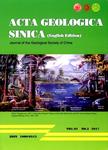Chemo-and Biostratigraphy of the Jurassic Oil Shales from the Qiangtang Basin,Northern Tibet,China:A Case Study of the Toarcian Oceanic Anoxic Event
Chemo-and Biostratigraphy of the Jurassic Oil Shales from the Qiangtang Basin,Northern Tibet,China:A Case Study of the Toarcian Oceanic Anoxic Event作者机构:Chongqing University of Science and TechnologyChongqing 401331China State Key Laboratory of Ore Deposit GeochemistryInstitute of GeochemistryChinese Academy of Sciences99 West Lincheng RoadGuiyang 550081China University of Chinese Academy of SciencesBeijing 100049China Institute of Sedimentary GeologyChengdu University of TechnologyChengdu 610059SichuanChina
出 版 物:《Acta Geologica Sinica(English Edition)》 (地质学报(英文版))
年 卷 期:2017年第91卷第2期
页 面:630-643页
核心收录:
学科分类:0709[理学-地质学] 0819[工学-矿业工程] 081803[工学-地质工程] 08[工学] 0818[工学-地质资源与地质工程] 0708[理学-地球物理学] 0816[工学-测绘科学与技术]
基 金:supported by the National Natural Science Foundation of China(grants No.41102066,41572095 and 41572089) Opening Foundation of the State Key Laboratory of Ore Deposit Geochemistry,Institute of Geochemistry,Chinese Academy of Sciences(grant No.201008) State Key Laboratory of Marine Geology,Tongji University(grant No.MGK1703)
主 题:oil shales geochemistry palaeontology T-OAE northern Tibet Proto-Tethys
摘 要:The marine oil shales of the Qiangtang Basin, northern Tibet, exposed in the Biluo Co, Tuonamu, Shenglihe and Changsheshan areas are believed to be important petroleum source rocks. This work comprehensively analyzed the carbon isotopes, trace elements, and calcareous nannofosills, ammonites and bivalves of the Biluo Co section in the Qiangtang Basin. The organic carbon isotopes show a positive excursion close to 2.17‰(relative to PDB), which, albeit significantly smaller, may also be associated with other Early Toarcian Oceanic Anoxic Events(T-OAE) in the European epicontinental seas and the Tethyan continental margins. Coinciding with the Early Toarcian transgression, the oxygen deficiency in bottom water had led to dysoxic-anoxic conditions and deposition of black shales lacking benthic fauna. Under such condition, the redox-sensitive trace metals such as Mo, V, Ni, Cr, and U were enriched, in conjunction with high planktonic productivity of Watznaueriaceae calcareous nannofossils. Comparison of the results with the records of chemo-and biostratigraphy, as well as the palaeogeography during the Early Jurassic suggests that the anoxia linked to the Early Toarcian oceanic anoxic event was mainly caused by the high surface water temperature, sea-level rise and an increase of surface water productivity.



